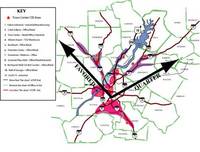The un-favored quarter: urbanism’s next frontier
New development is coming to Minnesota Avenue and Benning Road, near the Minnesota Avenue Metro Station. Yesterday’s Post, DCMud, and others wrote about the plans, which will feature more “affordable” and “market rate” apartments and condos.
This is very important because it’s a big step in development outside of the west-northwest “Favored Quarter” of our region, in an area that has seen little TOD. The Favored Quarter is the slice of a region with the highest property values. All post-suburban major American cities have them; in Baltimore it’s north-northwest, in Pittsburgh it’s south, etc. The largest, like New York, have multiple Favored Quarters.
It is no coincidence that when Montgomery County started TOD, it began in Bethesda, which is in the Favored Quarter. It was a good idea to experiment with a new idea in the world of real estate products in a place where the land was already highly valued. Only after TOD had demonstrated its success did the County try it in the revitalization of Silver Spring. At the time, both Silver Spring and Wheaton had been going through decades of decline because they weren’t in the Favored Quarter during the suburbanization era. They are, however, “Favored Quarter Adjacent,” and therefore less alien. Consequently, it was much easier to improve their reputations so that people could walk there and “feel safe.” In many ways, the Fenton St. development was mainly about having an attraction for people to visit and become familiar with walking and enjoying Silver Spring.
The pattern is similar on the other side of the Potomac. Tysons, an economically vibrant edge city, and the wonderfully urban Rosslyn-Ballston Corridor, are both in the Favored Quarter. Only after the success in North Arlington did Arlington County begin to think about revitalizing the Favored Quarter Adjacent Columbia Pike corridor. Likewise, in the District, first Georgetown and Dupont Circle revitalized, followed by Adams Morgan due to its proximity to the Favored Quarter. After that came U St. and Logan Circle, and most recently, Columbia Heights.
A common thread in each of these stories of urban revitalization is the appearance of new condos. Why did it start in the Favored Quarter and then radiate out, starting with those places closest to the Favored Quarter? Quite simply, the land was more expensive, so the developer could charge more for their products and make more money. There was less risk for them. As a consequence, this raised the average income in the area, creating more demand for amenities. Businesses then opened up, or existing ones thrived, meeting the new demand. During the housing bubble years of this decade, a developer could make a ton of money buying up old properties and redeveloping them into “luxury” condos for a hefty profit.
I personally don’t find this to be a completely bad thing because it satisfied pent-up demand for real estate in a walkable place. However, there is the unintended, less ideal flip side: it homogenized a neighborhood with respect to income. A long term economically sustainable walkable urban place needs residents with a mix of incomes.
How does this all tie back to the new development at the Minnesota Ave. Metro? This project is the beginning of the next step in urban development and planning in our region. Just like the Metro showed that people will take quality mass transit, even if they own their own car; just like Bethesda and North Arlington showed that you can sell new real estate in a walkable place in the age of the subdivision; just like Silver Spring and Columbia Heights and U Street showed that many people would love to pay good money to live in an old urban place that’s not in the Favored Quarter (but is Favored Quarter Adjacent)… this new market/affordable rate apartment/condo development at the Minnesota Avenue Metro has the potential to show developers that they can make a profit off urban housing that other than “luxury” condos and outside the Favored Quarter.
I hope the District and the developer make a deal that works out well for both parties. If the developer can turn a profit, many others will follow. That will be good for the District by attracting more residents. Those residents will then support the local businesses. The region will have another tool to create good urbanism in addition to what has already worked so well.
If we’re lucky, the process will continue for decades. It took decades of suburbanization to develop the current land value distributions. Maybe in another 60 years, there will be no more Favored Quarter, just Washington and its walkable urban suburbs.

